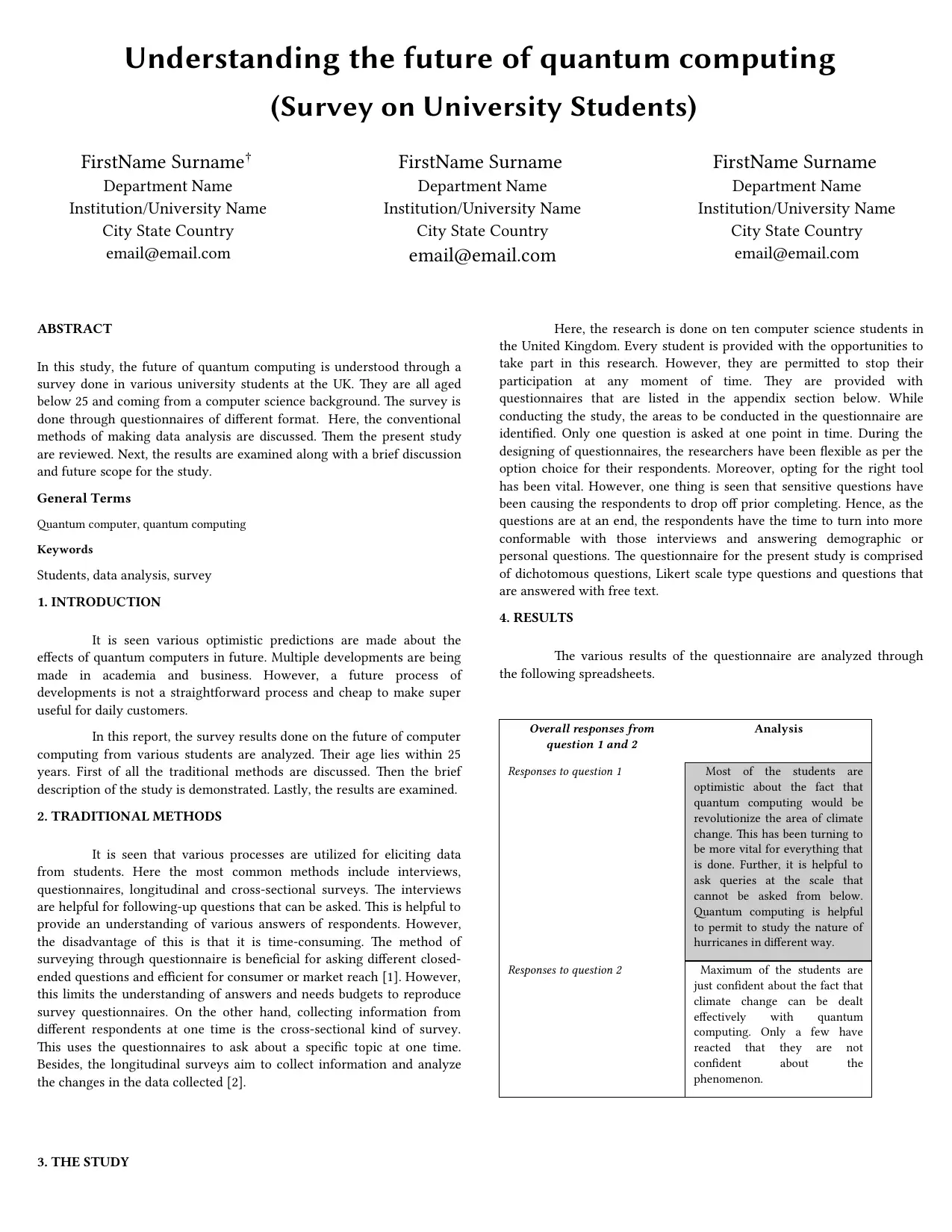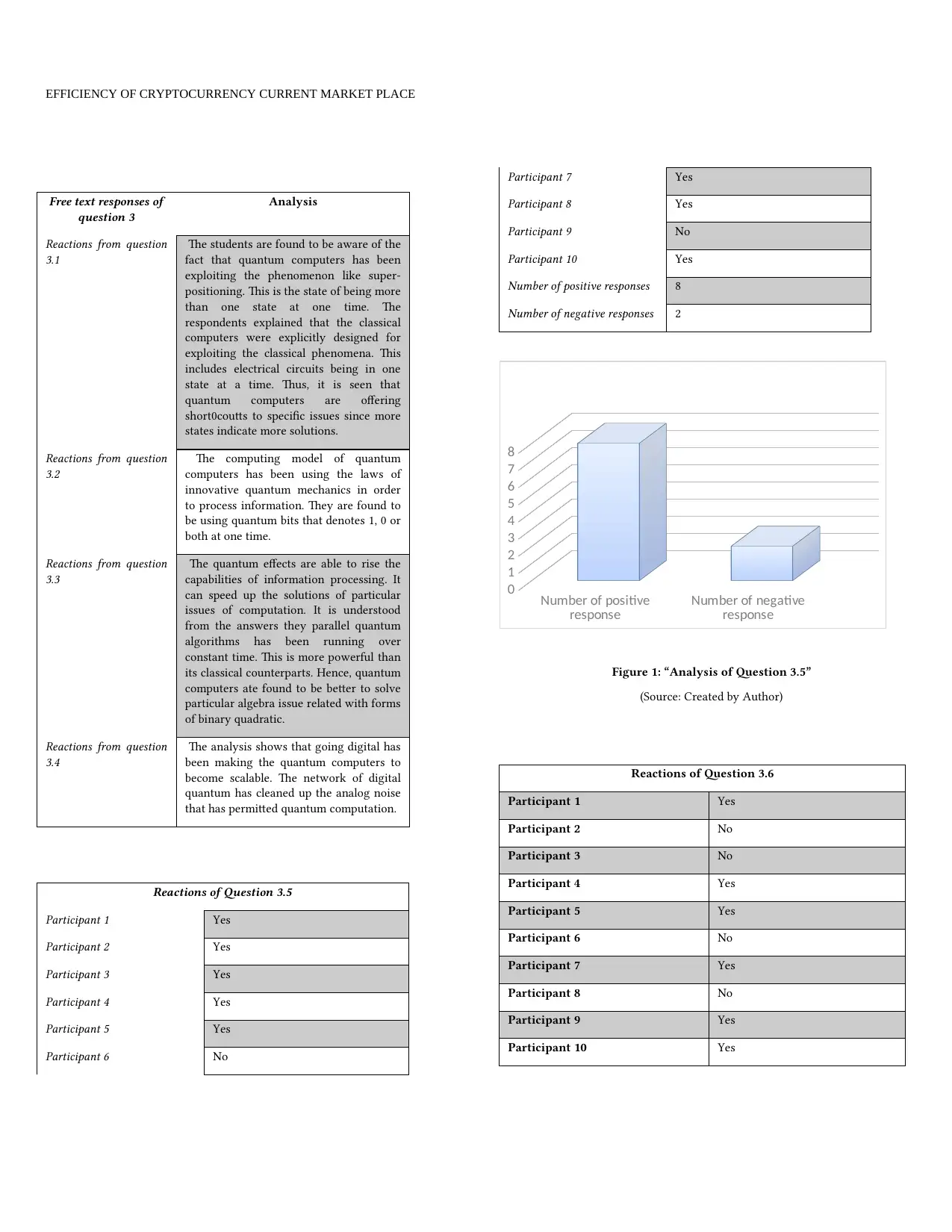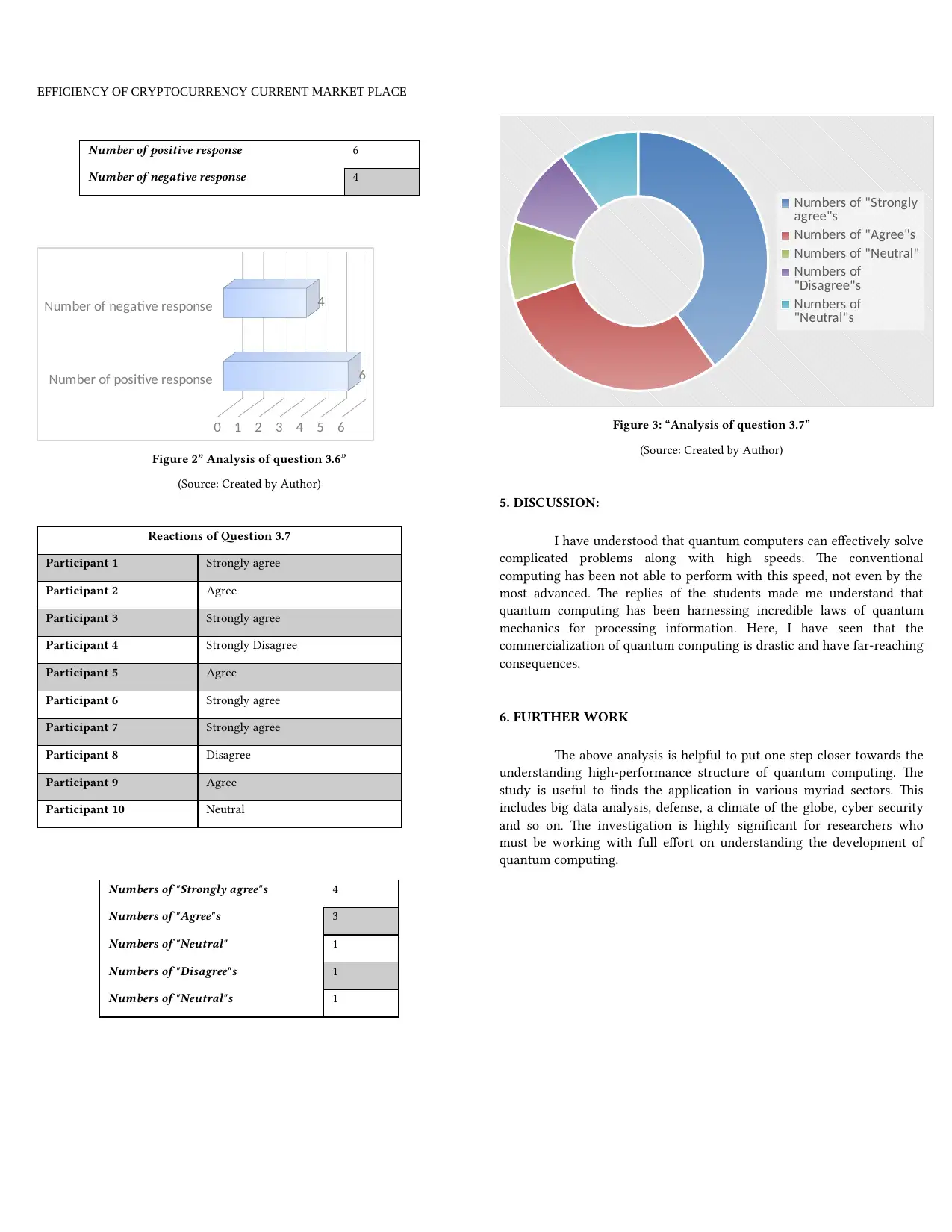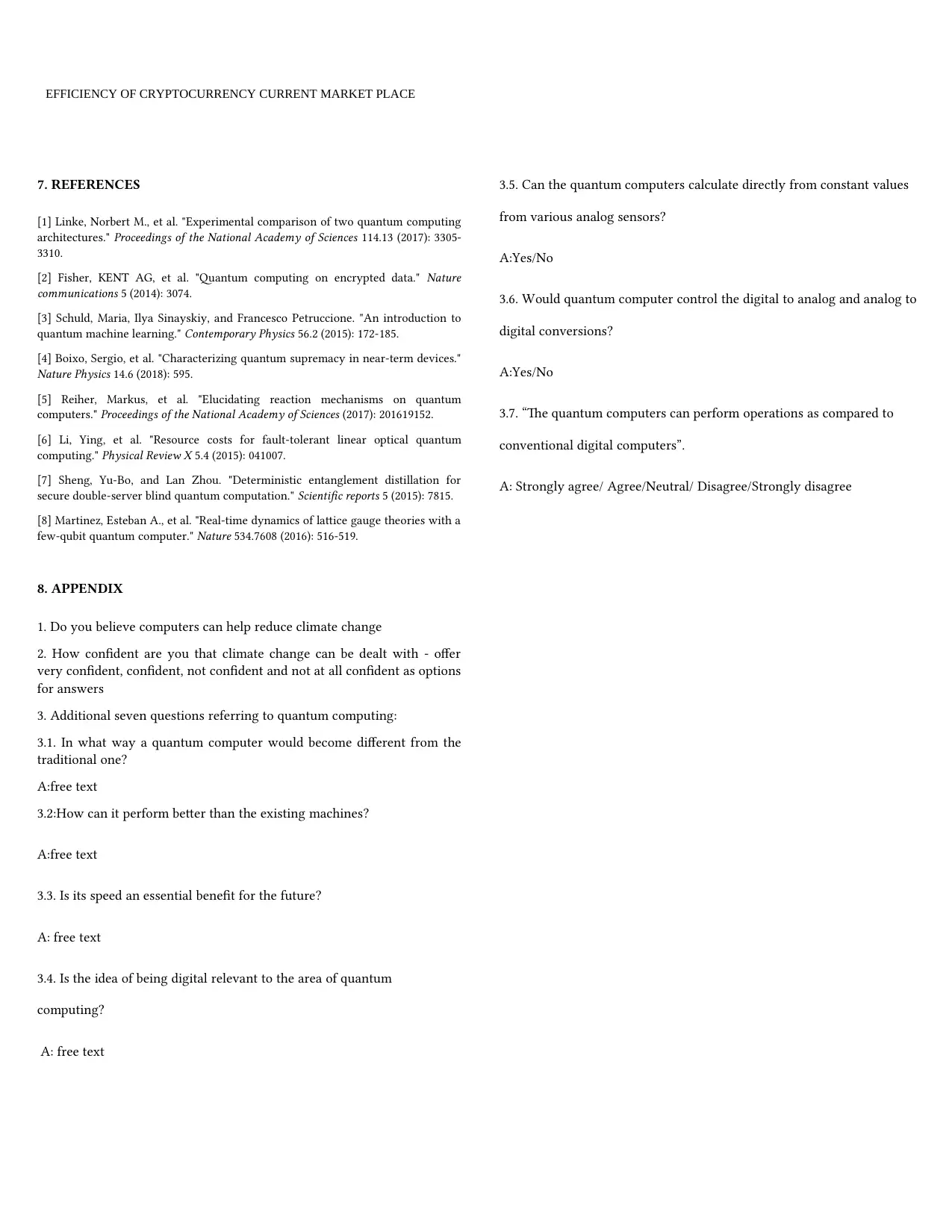CO4820 Critical Analysis: Quantum Computing Survey of UK Students
VerifiedAdded on 2023/05/28
|4
|1892
|413
Report
AI Summary
This report presents an analysis of a survey conducted among university students in the UK to understand their perspectives on the future of quantum computing. The survey, employing questionnaires with dichotomous, Likert scale, and free-text questions, explores students' awareness and expectations regarding quantum computing's potential impact, particularly in areas like climate change. The analysis covers traditional data elicitation methods, the study's design, and a detailed examination of the survey results, including student opinions on quantum computing's advantages over classical computing, its scalability, and its ability to solve complex problems. The report concludes with a discussion of the findings, highlighting the commercialization and far-reaching consequences of quantum computing, and suggests further research areas, emphasizing its potential applications in big data analysis, cybersecurity, and climate modeling. Desklib provides access to similar reports and solved assignments for students.

Understanding the future of quantum computing
(Survey on University Students)
FirstName Surname†
Department Name
Institution/University Name
City State Country
email@email.com
FirstName Surname
Department Name
Institution/University Name
City State Country
email@email.com
FirstName Surname
Department Name
Institution/University Name
City State Country
email@email.com
ABSTRACT
In this study, the future of quantum computing is understood through a
survey done in various university students at the UK. They are all aged
below 25 and coming from a computer science background. The survey is
done through questionnaires of different format. Here, the conventional
methods of making data analysis are discussed. Them the present study
are reviewed. Next, the results are examined along with a brief discussion
and future scope for the study.
General Terms
Quantum computer, quantum computing
Keywords
Students, data analysis, survey
1. INTRODUCTION
It is seen various optimistic predictions are made about the
effects of quantum computers in future. Multiple developments are being
made in academia and business. However, a future process of
developments is not a straightforward process and cheap to make super
useful for daily customers.
In this report, the survey results done on the future of computer
computing from various students are analyzed. Their age lies within 25
years. First of all the traditional methods are discussed. Then the brief
description of the study is demonstrated. Lastly, the results are examined.
2. TRADITIONAL METHODS
It is seen that various processes are utilized for eliciting data
from students. Here the most common methods include interviews,
questionnaires, longitudinal and cross-sectional surveys. The interviews
are helpful for following-up questions that can be asked. This is helpful to
provide an understanding of various answers of respondents. However,
the disadvantage of this is that it is time-consuming. The method of
surveying through questionnaire is beneficial for asking different closed-
ended questions and efficient for consumer or market reach [1]. However,
this limits the understanding of answers and needs budgets to reproduce
survey questionnaires. On the other hand, collecting information from
different respondents at one time is the cross-sectional kind of survey.
This uses the questionnaires to ask about a specific topic at one time.
Besides, the longitudinal surveys aim to collect information and analyze
the changes in the data collected [2].
3. THE STUDY
Here, the research is done on ten computer science students in
the United Kingdom. Every student is provided with the opportunities to
take part in this research. However, they are permitted to stop their
participation at any moment of time. They are provided with
questionnaires that are listed in the appendix section below. While
conducting the study, the areas to be conducted in the questionnaire are
identified. Only one question is asked at one point in time. During the
designing of questionnaires, the researchers have been flexible as per the
option choice for their respondents. Moreover, opting for the right tool
has been vital. However, one thing is seen that sensitive questions have
been causing the respondents to drop off prior completing. Hence, as the
questions are at an end, the respondents have the time to turn into more
conformable with those interviews and answering demographic or
personal questions. The questionnaire for the present study is comprised
of dichotomous questions, Likert scale type questions and questions that
are answered with free text.
4. RESULTS
The various results of the questionnaire are analyzed through
the following spreadsheets.
Overall responses from
question 1 and 2
Analysis
Responses to question 1 Most of the students are
optimistic about the fact that
quantum computing would be
revolutionize the area of climate
change. This has been turning to
be more vital for everything that
is done. Further, it is helpful to
ask queries at the scale that
cannot be asked from below.
Quantum computing is helpful
to permit to study the nature of
hurricanes in different way.
Responses to question 2 Maximum of the students are
just confident about the fact that
climate change can be dealt
effectively with quantum
computing. Only a few have
reacted that they are not
confident about the
phenomenon.
(Survey on University Students)
FirstName Surname†
Department Name
Institution/University Name
City State Country
email@email.com
FirstName Surname
Department Name
Institution/University Name
City State Country
email@email.com
FirstName Surname
Department Name
Institution/University Name
City State Country
email@email.com
ABSTRACT
In this study, the future of quantum computing is understood through a
survey done in various university students at the UK. They are all aged
below 25 and coming from a computer science background. The survey is
done through questionnaires of different format. Here, the conventional
methods of making data analysis are discussed. Them the present study
are reviewed. Next, the results are examined along with a brief discussion
and future scope for the study.
General Terms
Quantum computer, quantum computing
Keywords
Students, data analysis, survey
1. INTRODUCTION
It is seen various optimistic predictions are made about the
effects of quantum computers in future. Multiple developments are being
made in academia and business. However, a future process of
developments is not a straightforward process and cheap to make super
useful for daily customers.
In this report, the survey results done on the future of computer
computing from various students are analyzed. Their age lies within 25
years. First of all the traditional methods are discussed. Then the brief
description of the study is demonstrated. Lastly, the results are examined.
2. TRADITIONAL METHODS
It is seen that various processes are utilized for eliciting data
from students. Here the most common methods include interviews,
questionnaires, longitudinal and cross-sectional surveys. The interviews
are helpful for following-up questions that can be asked. This is helpful to
provide an understanding of various answers of respondents. However,
the disadvantage of this is that it is time-consuming. The method of
surveying through questionnaire is beneficial for asking different closed-
ended questions and efficient for consumer or market reach [1]. However,
this limits the understanding of answers and needs budgets to reproduce
survey questionnaires. On the other hand, collecting information from
different respondents at one time is the cross-sectional kind of survey.
This uses the questionnaires to ask about a specific topic at one time.
Besides, the longitudinal surveys aim to collect information and analyze
the changes in the data collected [2].
3. THE STUDY
Here, the research is done on ten computer science students in
the United Kingdom. Every student is provided with the opportunities to
take part in this research. However, they are permitted to stop their
participation at any moment of time. They are provided with
questionnaires that are listed in the appendix section below. While
conducting the study, the areas to be conducted in the questionnaire are
identified. Only one question is asked at one point in time. During the
designing of questionnaires, the researchers have been flexible as per the
option choice for their respondents. Moreover, opting for the right tool
has been vital. However, one thing is seen that sensitive questions have
been causing the respondents to drop off prior completing. Hence, as the
questions are at an end, the respondents have the time to turn into more
conformable with those interviews and answering demographic or
personal questions. The questionnaire for the present study is comprised
of dichotomous questions, Likert scale type questions and questions that
are answered with free text.
4. RESULTS
The various results of the questionnaire are analyzed through
the following spreadsheets.
Overall responses from
question 1 and 2
Analysis
Responses to question 1 Most of the students are
optimistic about the fact that
quantum computing would be
revolutionize the area of climate
change. This has been turning to
be more vital for everything that
is done. Further, it is helpful to
ask queries at the scale that
cannot be asked from below.
Quantum computing is helpful
to permit to study the nature of
hurricanes in different way.
Responses to question 2 Maximum of the students are
just confident about the fact that
climate change can be dealt
effectively with quantum
computing. Only a few have
reacted that they are not
confident about the
phenomenon.
Paraphrase This Document
Need a fresh take? Get an instant paraphrase of this document with our AI Paraphraser

EFFICIENCY OF CRYPTOCURRENCY CURRENT MARKET PLACE
Free text responses of
question 3
Analysis
Reactions from question
3.1
The students are found to be aware of the
fact that quantum computers has been
exploiting the phenomenon like super-
positioning. This is the state of being more
than one state at one time. The
respondents explained that the classical
computers were explicitly designed for
exploiting the classical phenomena. This
includes electrical circuits being in one
state at a time. Thus, it is seen that
quantum computers are offering
short0coutts to specific issues since more
states indicate more solutions.
Reactions from question
3.2
The computing model of quantum
computers has been using the laws of
innovative quantum mechanics in order
to process information. They are found to
be using quantum bits that denotes 1, 0 or
both at one time.
Reactions from question
3.3
The quantum effects are able to rise the
capabilities of information processing. It
can speed up the solutions of particular
issues of computation. It is understood
from the answers they parallel quantum
algorithms has been running over
constant time. This is more powerful than
its classical counterparts. Hence, quantum
computers ate found to be better to solve
particular algebra issue related with forms
of binary quadratic.
Reactions from question
3.4
The analysis shows that going digital has
been making the quantum computers to
become scalable. The network of digital
quantum has cleaned up the analog noise
that has permitted quantum computation.
Reactions of Question 3.5
Participant 1 Yes
Participant 2 Yes
Participant 3 Yes
Participant 4 Yes
Participant 5 Yes
Participant 6 No
Participant 7 Yes
Participant 8 Yes
Participant 9 No
Participant 10 Yes
Number of positive responses 8
Number of negative responses 2
Number of positive
response Number of negative
response
0
1
2
3
4
5
6
7
8
Figure 1: “Analysis of Question 3.5”
(Source: Created by Author)
Reactions of Question 3.6
Participant 1 Yes
Participant 2 No
Participant 3 No
Participant 4 Yes
Participant 5 Yes
Participant 6 No
Participant 7 Yes
Participant 8 No
Participant 9 Yes
Participant 10 Yes
Free text responses of
question 3
Analysis
Reactions from question
3.1
The students are found to be aware of the
fact that quantum computers has been
exploiting the phenomenon like super-
positioning. This is the state of being more
than one state at one time. The
respondents explained that the classical
computers were explicitly designed for
exploiting the classical phenomena. This
includes electrical circuits being in one
state at a time. Thus, it is seen that
quantum computers are offering
short0coutts to specific issues since more
states indicate more solutions.
Reactions from question
3.2
The computing model of quantum
computers has been using the laws of
innovative quantum mechanics in order
to process information. They are found to
be using quantum bits that denotes 1, 0 or
both at one time.
Reactions from question
3.3
The quantum effects are able to rise the
capabilities of information processing. It
can speed up the solutions of particular
issues of computation. It is understood
from the answers they parallel quantum
algorithms has been running over
constant time. This is more powerful than
its classical counterparts. Hence, quantum
computers ate found to be better to solve
particular algebra issue related with forms
of binary quadratic.
Reactions from question
3.4
The analysis shows that going digital has
been making the quantum computers to
become scalable. The network of digital
quantum has cleaned up the analog noise
that has permitted quantum computation.
Reactions of Question 3.5
Participant 1 Yes
Participant 2 Yes
Participant 3 Yes
Participant 4 Yes
Participant 5 Yes
Participant 6 No
Participant 7 Yes
Participant 8 Yes
Participant 9 No
Participant 10 Yes
Number of positive responses 8
Number of negative responses 2
Number of positive
response Number of negative
response
0
1
2
3
4
5
6
7
8
Figure 1: “Analysis of Question 3.5”
(Source: Created by Author)
Reactions of Question 3.6
Participant 1 Yes
Participant 2 No
Participant 3 No
Participant 4 Yes
Participant 5 Yes
Participant 6 No
Participant 7 Yes
Participant 8 No
Participant 9 Yes
Participant 10 Yes

EFFICIENCY OF CRYPTOCURRENCY CURRENT MARKET PLACE
Number of positive response 6
Number of negative response 4
Number of positive response
Number of negative response
0 1 2 3 4 5 6
6
4
Figure 2” Analysis of question 3.6”
(Source: Created by Author)
Reactions of Question 3.7
Participant 1 Strongly agree
Participant 2 Agree
Participant 3 Strongly agree
Participant 4 Strongly Disagree
Participant 5 Agree
Participant 6 Strongly agree
Participant 7 Strongly agree
Participant 8 Disagree
Participant 9 Agree
Participant 10 Neutral
Numbers of "Strongly agree"s 4
Numbers of "Agree"s 3
Numbers of "Neutral" 1
Numbers of "Disagree"s 1
Numbers of "Neutral"s 1
Numbers of "Strongly
agree"s
Numbers of "Agree"s
Numbers of "Neutral"
Numbers of
"Disagree"s
Numbers of
"Neutral"s
Figure 3: “Analysis of question 3.7”
(Source: Created by Author)
5. DISCUSSION:
I have understood that quantum computers can effectively solve
complicated problems along with high speeds. The conventional
computing has been not able to perform with this speed, not even by the
most advanced. The replies of the students made me understand that
quantum computing has been harnessing incredible laws of quantum
mechanics for processing information. Here, I have seen that the
commercialization of quantum computing is drastic and have far-reaching
consequences.
6. FURTHER WORK
The above analysis is helpful to put one step closer towards the
understanding high-performance structure of quantum computing. The
study is useful to finds the application in various myriad sectors. This
includes big data analysis, defense, a climate of the globe, cyber security
and so on. The investigation is highly significant for researchers who
must be working with full effort on understanding the development of
quantum computing.
Number of positive response 6
Number of negative response 4
Number of positive response
Number of negative response
0 1 2 3 4 5 6
6
4
Figure 2” Analysis of question 3.6”
(Source: Created by Author)
Reactions of Question 3.7
Participant 1 Strongly agree
Participant 2 Agree
Participant 3 Strongly agree
Participant 4 Strongly Disagree
Participant 5 Agree
Participant 6 Strongly agree
Participant 7 Strongly agree
Participant 8 Disagree
Participant 9 Agree
Participant 10 Neutral
Numbers of "Strongly agree"s 4
Numbers of "Agree"s 3
Numbers of "Neutral" 1
Numbers of "Disagree"s 1
Numbers of "Neutral"s 1
Numbers of "Strongly
agree"s
Numbers of "Agree"s
Numbers of "Neutral"
Numbers of
"Disagree"s
Numbers of
"Neutral"s
Figure 3: “Analysis of question 3.7”
(Source: Created by Author)
5. DISCUSSION:
I have understood that quantum computers can effectively solve
complicated problems along with high speeds. The conventional
computing has been not able to perform with this speed, not even by the
most advanced. The replies of the students made me understand that
quantum computing has been harnessing incredible laws of quantum
mechanics for processing information. Here, I have seen that the
commercialization of quantum computing is drastic and have far-reaching
consequences.
6. FURTHER WORK
The above analysis is helpful to put one step closer towards the
understanding high-performance structure of quantum computing. The
study is useful to finds the application in various myriad sectors. This
includes big data analysis, defense, a climate of the globe, cyber security
and so on. The investigation is highly significant for researchers who
must be working with full effort on understanding the development of
quantum computing.
You're viewing a preview
Unlock full access by subscribing today!

EFFICIENCY OF CRYPTOCURRENCY CURRENT MARKET PLACE
7. REFERENCES
[1] Linke, Norbert M., et al. "Experimental comparison of two quantum computing
architectures." Proceedings of the National Academy of Sciences 114.13 (2017): 3305-
3310.
[2] Fisher, KENT AG, et al. "Quantum computing on encrypted data." Nature
communications 5 (2014): 3074.
[3] Schuld, Maria, Ilya Sinayskiy, and Francesco Petruccione. "An introduction to
quantum machine learning." Contemporary Physics 56.2 (2015): 172-185.
[4] Boixo, Sergio, et al. "Characterizing quantum supremacy in near-term devices."
Nature Physics 14.6 (2018): 595.
[5] Reiher, Markus, et al. "Elucidating reaction mechanisms on quantum
computers." Proceedings of the National Academy of Sciences (2017): 201619152.
[6] Li, Ying, et al. "Resource costs for fault-tolerant linear optical quantum
computing." Physical Review X 5.4 (2015): 041007.
[7] Sheng, Yu-Bo, and Lan Zhou. "Deterministic entanglement distillation for
secure double-server blind quantum computation." Scientific reports 5 (2015): 7815.
[8] Martinez, Esteban A., et al. "Real-time dynamics of lattice gauge theories with a
few-qubit quantum computer." Nature 534.7608 (2016): 516-519.
8. APPENDIX
1. Do you believe computers can help reduce climate change
2. How confident are you that climate change can be dealt with - offer
very confident, confident, not confident and not at all confident as options
for answers
3. Additional seven questions referring to quantum computing:
3.1. In what way a quantum computer would become different from the
traditional one?
A:free text
3.2:How can it perform better than the existing machines?
A:free text
3.3. Is its speed an essential benefit for the future?
A: free text
3.4. Is the idea of being digital relevant to the area of quantum
computing?
A: free text
3.5. Can the quantum computers calculate directly from constant values
from various analog sensors?
A:Yes/No
3.6. Would quantum computer control the digital to analog and analog to
digital conversions?
A:Yes/No
3.7. “The quantum computers can perform operations as compared to
conventional digital computers”.
A: Strongly agree/ Agree/Neutral/ Disagree/Strongly disagree
7. REFERENCES
[1] Linke, Norbert M., et al. "Experimental comparison of two quantum computing
architectures." Proceedings of the National Academy of Sciences 114.13 (2017): 3305-
3310.
[2] Fisher, KENT AG, et al. "Quantum computing on encrypted data." Nature
communications 5 (2014): 3074.
[3] Schuld, Maria, Ilya Sinayskiy, and Francesco Petruccione. "An introduction to
quantum machine learning." Contemporary Physics 56.2 (2015): 172-185.
[4] Boixo, Sergio, et al. "Characterizing quantum supremacy in near-term devices."
Nature Physics 14.6 (2018): 595.
[5] Reiher, Markus, et al. "Elucidating reaction mechanisms on quantum
computers." Proceedings of the National Academy of Sciences (2017): 201619152.
[6] Li, Ying, et al. "Resource costs for fault-tolerant linear optical quantum
computing." Physical Review X 5.4 (2015): 041007.
[7] Sheng, Yu-Bo, and Lan Zhou. "Deterministic entanglement distillation for
secure double-server blind quantum computation." Scientific reports 5 (2015): 7815.
[8] Martinez, Esteban A., et al. "Real-time dynamics of lattice gauge theories with a
few-qubit quantum computer." Nature 534.7608 (2016): 516-519.
8. APPENDIX
1. Do you believe computers can help reduce climate change
2. How confident are you that climate change can be dealt with - offer
very confident, confident, not confident and not at all confident as options
for answers
3. Additional seven questions referring to quantum computing:
3.1. In what way a quantum computer would become different from the
traditional one?
A:free text
3.2:How can it perform better than the existing machines?
A:free text
3.3. Is its speed an essential benefit for the future?
A: free text
3.4. Is the idea of being digital relevant to the area of quantum
computing?
A: free text
3.5. Can the quantum computers calculate directly from constant values
from various analog sensors?
A:Yes/No
3.6. Would quantum computer control the digital to analog and analog to
digital conversions?
A:Yes/No
3.7. “The quantum computers can perform operations as compared to
conventional digital computers”.
A: Strongly agree/ Agree/Neutral/ Disagree/Strongly disagree
1 out of 4
Related Documents
Your All-in-One AI-Powered Toolkit for Academic Success.
+13062052269
info@desklib.com
Available 24*7 on WhatsApp / Email
![[object Object]](/_next/static/media/star-bottom.7253800d.svg)
Unlock your academic potential
© 2024 | Zucol Services PVT LTD | All rights reserved.





